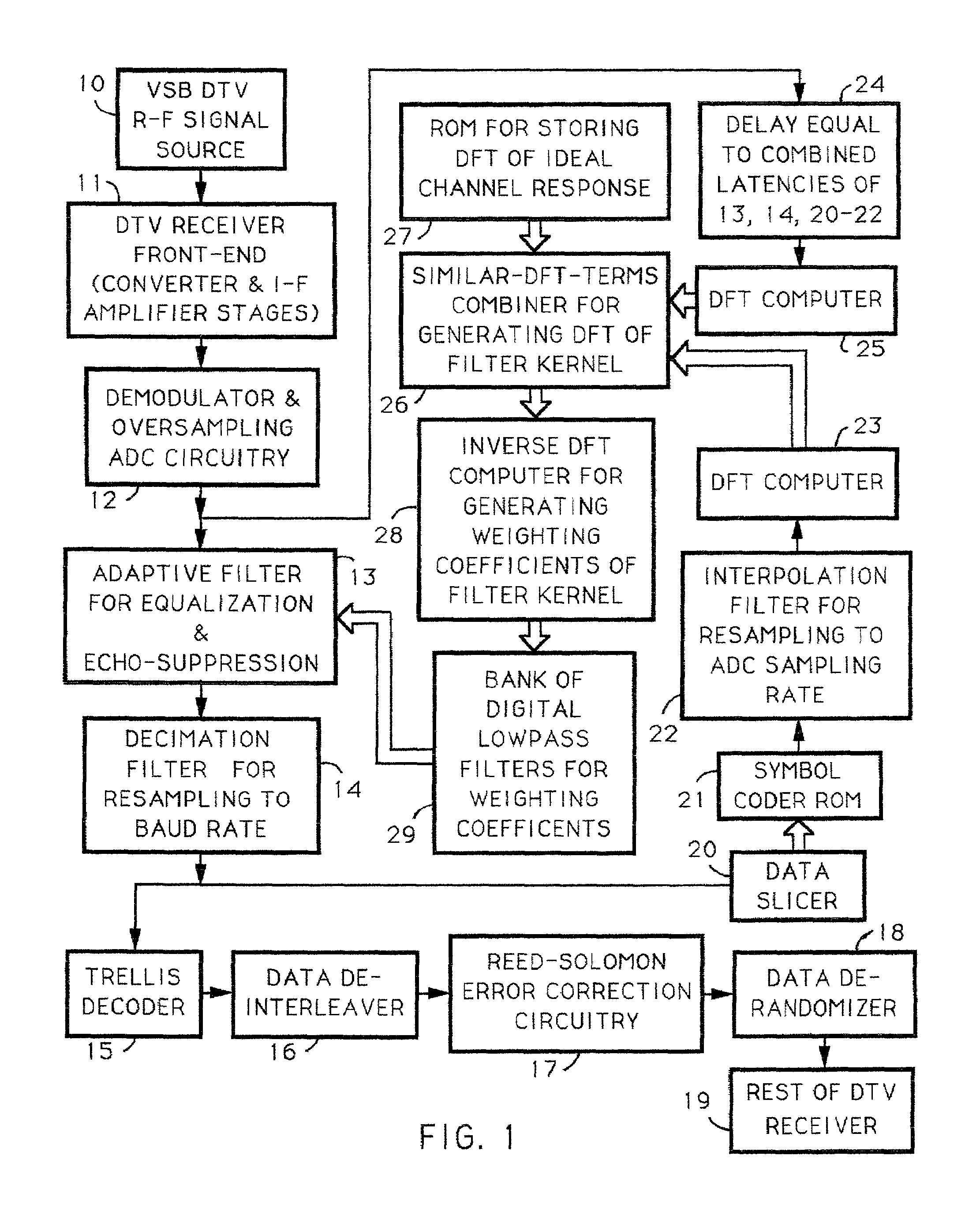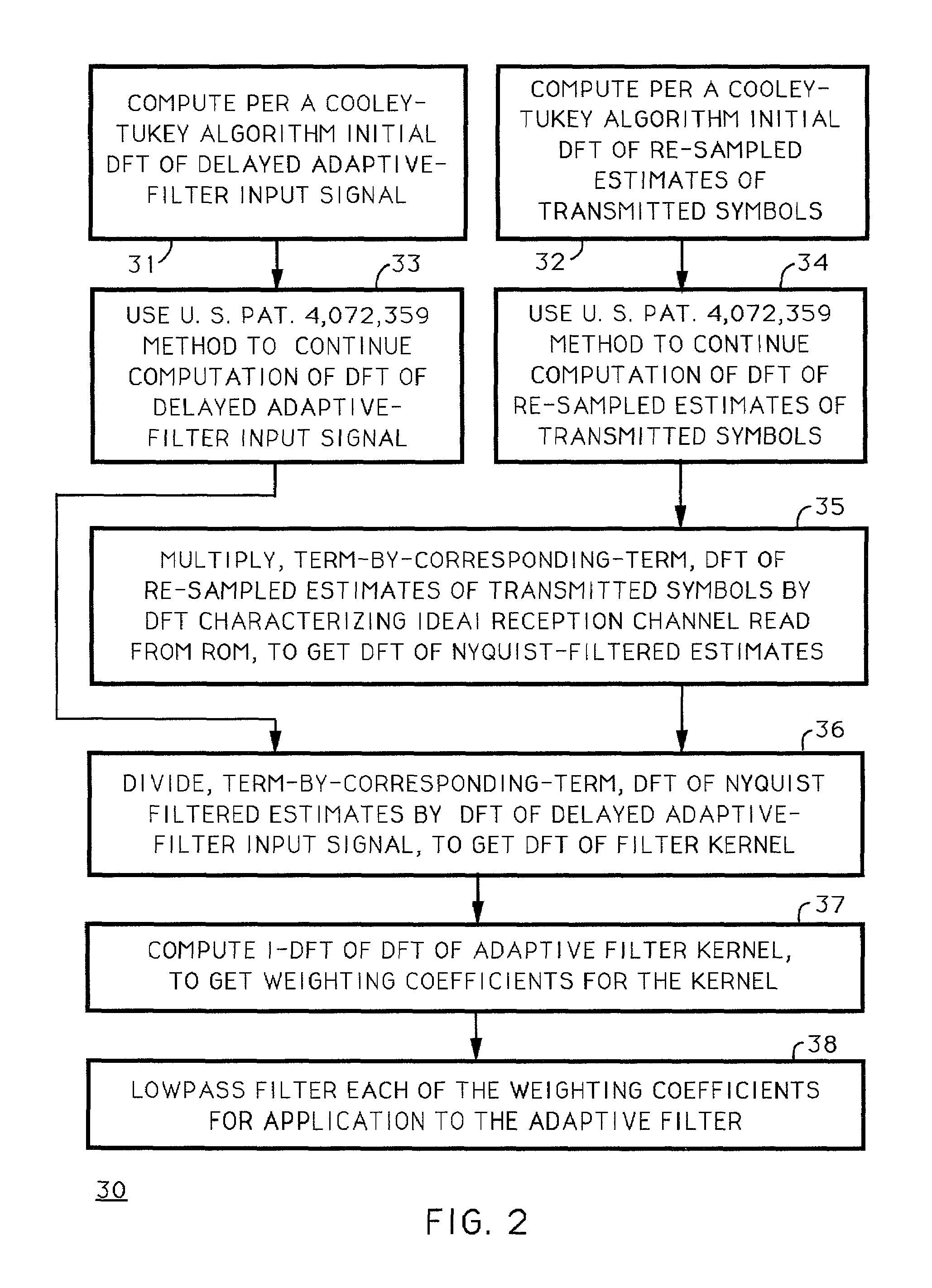It is possible however, that the direct or shortest path signal is not the signal to which the
receiver synchronizes.
Blind-equalization methods have been resorted to for determining the weighting coefficients of adaptive filtering used for equalization and echo-suppression in receivers for ATSC
digital television (DTV) signals, because the ATSC DTV signal does not provide a good training signal for procedures similar to those described in the preceding
paragraph.
The design of the DFS signal does not avoid the PN signals being overlapped by the echoes of previous data in the DTV signal that have significant energy, however, nor does the design avoid some echoes of these PN signals that have significant energy overlapping subsequent data in the DTV signal.
Consequently, even though the PN signals have auto-correlation functions that might suit them for match filtering, the DFS signals have not proven in
actual practice to be satisfactory training signals for adaptive equalization and echo-suppression filtering, because echoes of the PN signals are not readily distinguishable from other data and their echoes.
LMS-gradient algorithms used in data-directed equalization methods are quite slow and are prone to stalling at local minima in the decision-feedback
error signal, rather than continuing to the minimal decision-feedback
error signal condition overall.
Initialization of the adaptive filtering used for equalization and ghost cancellation normally takes a second or so after the reception channel is changed, which makes
channel surfing difficult.
LMS-gradient algorithms adapt slowly, so rapidly occurring changes in multipath conditions cannot be followed.
This will at times lead to the weighting coefficients being completely erroneous for changed multipath condition, causing data
slicing errors frequently enough that the error-correction capabilities of the
system are overwhelmed.
Continuously changing multipath conditions can cause a loss of tracking in which data
slicing errors too frequent to be corrected persist over protracted intervals many seconds long.
However, the tracking performance is influenced not only by the
rate of convergence (which is a transient characteristic) but also by fluctuation of the steady-state performance of the
algorithm as influenced by measurement and
algorithm noise.
Moreover, dynamic multipath conditions tend to be more troublesome during weak-signal reception where the convergence of the RLS
algorithm is not so much greater than that of the LMS-gradient algorithm is not so much greater than that of the LMS-gradient algorithms.
RLS methods generally involve a computational cost that increases about as the square of the number of taps contained in the
adaptive filter.
This is a prohibitively high cost for a
DTV receiver designed for use in homes.
The fast transversal filters (FTF) algorithms realize the RLS solution with a computational cost that increases only linearly with the number of taps contained in the
adaptive filter, as in the LMS-gradient algorithms.
The computational cost of the FTF algorithms is at least four times larger than that for the LMS-gradient algorithms, however, with division calculations being required.
The more intractable problem with FTF algorithms is a potential explosive
instability arising from word-length limitations in the weighting-coefficient computer causing accumulated
rounding errors.
Such methods increase computational complexity by another 15% or so.
The hand-off to the LMS-gradient algorithm also increases computational complexity.
Tracking of the adaptive filtering may be impossible to recover unless a complete re-initialization of its weighting coefficients can be accomplished before there is another sudden change in dynamic
multipath reception conditions.
The problem is that objects moving at fairly low velocity can at times interrupt reception from one of two reception paths of similar strength to cause tremendous changes in signal phase that are nearly “instantaneous”.
A few seconds is simply too long, particularly since audio as well as video is lost.
Auto-regressive spectral analyses are handicapped in regard to how rapidly the weighting coefficients of the adaptive filtering can be re-initialized after tracking is lost.
The speed of re-initialization is limited not only by the latency of the adaptive filtering used for equalization and echo-suppression, however, but additionally by the latency associated with computation of the weighting coefficients from the decision-feedback error signals.
The serial, rather than parallel, computation of updates for the weighting coefficients slows the
adaptation of the filtering used for equalization and echo-suppression, particularly when block updating of the kernel weighting coefficients is done.
This sort of operating method tends to take considerable time to perform, since these steps N(3M+2) in number have to be performed at the normal sampling rate through the
adaptive filterThe
noise comprises quantization
noise generated in the digital portion of the receiver, Johnson noise from the analog portion of the receiver,
impulse noise in the reception channel and possibly co-channel interference from
NTSC analog television signals or from other ATSC DTV signals.
 Login to View More
Login to View More  Login to View More
Login to View More 


